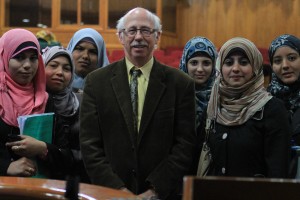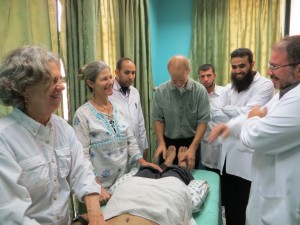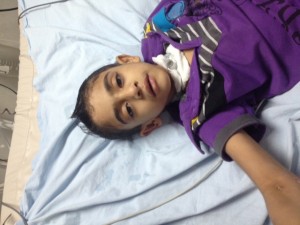We are told the Gaza siege is internal and external, by Gerri Haynes
(Gerri Haynes, former president of Washington Physicians for Social Responsibility, has returned to Gaza with a delegation of doctors, nurses and others interested in helping the people there. Gerri will be sending back reports.)
Day Four in Gaza
The complexities of politics are reflected in nearly all of life here. Living under Israeli siege and having extremely limited ability to move outside this 25-mile-long strip of guarded land and sea presents challenges to every citizen.We see more building and newer cars than one year ago, but are told by many that this reflects that a few are profiting, while climbing prices are making life even more difficult for the vast majority of people. The tunnel economy, regulated by the government, seems to be thriving, but the tunnels remain dangerous and we hear regularly about people being crushed in tunnel collapses.
There are two primary political parties here (Fatah and Hamas – with Hamas maintaining the government) and many small parties – not all of them working congenially or with basic agreements. Life is difficult. One agency director told us today that the siege is not only external but, because of the constant and continuous threat to life, the siege has also become internal.
This afternoon, planes flew overhead (always an ominous sound here) and the shudder of a bomb filled the air – this is such a common occurrence that when I asked several locals about it, they shrugged and said, “It is normal.” In the meantime, there is a folk festival tonight in Jabalyia Refugee Camp and four members of our group are headed there with local friends.
My great Kirkland neighbor, Susan, made forty boxes of delicious candy for me to bring to Gaza. Everyone who tastes this candy has a big smile – “thank you” to Susan for this yummy gift!Dr. Bob Haynes and Dr. Bill Dienst are continuing with classes in advanced life support. Today, they offered a class in the Islamic University School of Nursing (men and women students are segregated in this school, in classes as well as in the elevators).
The Islamic University has 800 nursing students (four year baccalaureate program) and 200 in the two-year midwifery program. Bob was told that all of the nurses will have employment when they graduate, but medical students look forward to 70 – 80 percent employment as physicians (after their internship year) and many will go abroad for specialty training.
Nikki Nichols writes:
“I came to Gaza to serve. Tuesday gave me that opportunity when we (two massage therapists and a chiropractor) worked together on a war-wounded man with low back pain. During the last war, Nov 2012, a rocket exploded near this man and shrapnel and debris invaded his body, destroying his intestines. Surgery left him without a spleen, only part of his intestines and a long scar from his neck to his abdomen.
“I did cross fiber friction on his scar and recommended that he do this regularly using Vitamin E oil (if it is available). Back surgery for his injuries left him with back pain that radiated down his leg to his feet. Our team massaged him while getting his feedback. At one point the patient was surrounded by about 10 people- our team of three, physiotherapists who work at the hospital (and with whom we enjoyed sharing knowledge), hospital administrators (including an interpreter), and representatives from the government‘s Ministry of Health. Lots of attention and healing energy was focused on the patient. I was glad to be part of the team!“Basman, the grant coordinator for the El Wafa Rehabilitation Hospital where we were working, was an excellent interpreter during our work. Basman lived in the USA for 45 years and said he is very happy to be home in Gaza. Looking out his office window, Israeli guard towers and the wasted fertile farmland that lies between the hospital and the Israeli Wall are visible. This land could produce food for hundreds of Gazans, people who are extremely short of food supplies, but it is in the “no go” zone – an area deemed too close to the Israeli Wall (for security reasons).
“El Wafa Medical Rehabilitation Hospital has lots of impressive equipment but some sits idle because of inability to obtain parts and maintain service due to the blockade. This hospital gets donations from many countries, not including the USA. It serves a population that is served by no other place in Gaza.
“We had an extensive tour of the hospital, seeing patients who demonstrated various effects of the blockade and wars. Some lay in contorted positions as they had been electrocuted while trying to obtain electricity from power poles for their families. Some had wounds from land mines and some had horrible wounds from road traffic accidents. I am thankful that El Wafa is present to serve this needy population.”
RSS feed for comments on this post. TrackBack URI


